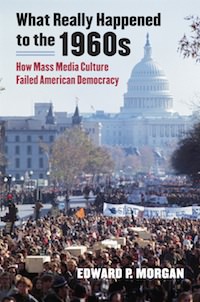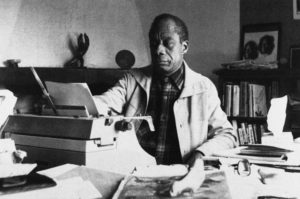The Myth of the ’60s
Edward P. Morgan, in this excerpt from “What Really Happened to the 1960s: How Mass Media Culture Failed American Democracy,” maintains that “the mass media’s ‘’60s’ discourse is chiefly one of ghosts, accusations, and smoke and mirrors that has long played on audience emotions and diverted public attention to what is essentially a symbolic form of spectator politics.”
Excerpted from “What Really Happened to the 1960s: How Mass Media Culture Failed American Democracy” by Edward P. Morgan. This excerpt is adapted from the published book by the author, with permission.
I begin the book with a discussion of how the unending “battles of the 1960s,” as candidate Barack Obama put it, were a significant and at times poignant backdrop to the 2008 presidential campaign. Such is the nature of political discourse in the American mass media culture. Something called “the Sixties” is alluded to again and again at regular intervals: presidential campaigns, repeated acts of war by the United States, outbursts of mass protest, episodes of racial unrest, abortion battles, charges of “political correctness,” to say nothing of media-saturated anniversaries of iconic sixties events, from Martin Luther King’s “I Have a Dream” speech to Woodstock.
I maintain that the mass media’s “sixties” discourse is chiefly one of ghosts, accusations, and smoke and mirrors that has long played on audience emotions and diverted public attention to what is essentially a symbolic form of spectator politics. In a commentary that represents perhaps the archetypal media culture representation, commentator Andrew Sullivan referred to these as the “debilitating, self-perpetuating family quarrel of the Baby Boom generation that has long engulfed all of us.”1 [See footnotes at end of article.] Sullivan is right in one sense; this media discourse is debilitating if we aspire to a democratic way of life. On the other hand, the archetypal media argument is also wrong in two respects. These “battles of the 1960s” were not, and are not, a generational quarrel. Notwithstanding media representations, sixties battles were about racism, poverty, war, meaningful education, the rat race, sexism, and ecological destruction. But, second, these political concerns are not even battles of the sixties. Lo and behold, while minorities and women have made great gains within the social mainstream, contemporary American life is marked by wars the people oppose yet cannot stop; poverty and a racially identifiable underclass that lives without hope; the growth of an obscenely wealthy class of the super-rich combined with an eroding middle class; an educational system increasingly driven by the bottom line that leaves young people more trapped in a rat race than were their sixties forebears; ongoing violence toward women in a society that continues to bombard us with images of pumped-up militarism; and an ecosphere that is showing far more fundamental signs of deterioration than it did in the earlier era of Earth Day environmentalism.
What Really Happened to the 1960s: How Mass Media Culture Failed American Democracy
By Edward P. Morgan
University Press of Kansas, 405 pages
I revisit this past because it can tell us a lot about where we are today and why we are there. It can also shed important light on the kinds of complex issues we face if we are to strengthen rather than lose our democratic way of life.
“The Sixties” in Mass Media Discourse
Presidential campaigns have for more than forty years exploited symbols, images, and personalities from the 1960s era as a means of mobilizing political support for their candidates and political agendas. For the most part, these campaigns have come from the right side of the political spectrum. Over time, they have blamed “the sixties” for just about everything they see as wrong with America. Beginning as far back as Barry Goldwater’s 1964 presidential campaign, political forces on the Right have used sixties-era media images to tap into the fears and resentments the spectacle spawned and thus to buttress their political agendas aimed largely at what they like to call “Big Government.” During the 1960s, these attacks began to pull significant populations—most notably the white South and portions of the Catholic working class—out of the Democratic Party’s New Deal coalition into the Republican camp.
With the economy floundering in the early to mid-1970s, capitalism’s elites sought to redress what they saw as the “excess of democracy” or “democratic distemper” of the sixties era in order to move public policy to the right.2 Rightist and corporate agendas converged with the election of Ronald Reagan in 1980, a turning point that not only produced the neoliberal (or what is misleadingly called a “free market”) regime that has dominated American politics ever since,3 but has succeeded in transforming American political discourse in the process. The Reagan agenda implemented earlier corporate calls for a sharp reduction in liberal government, a major shift toward privatization and free-market policies, and a new surge in military spending coupled with a more aggressive U.S. foreign policy—a reversal of the so-called “Vietnam syndrome.”
Despite policies geared to the interests of corporations and the wealthy, neoliberalism enjoyed wide electoral success because it was ushered in by rhetoric that effectively played off public images of the sixties—threatening black militants, rebellious students, Viet Cong flag-waving antiwar protesters, self-indulgent and stoned hippies, and “man-hating” or “family-hating” women—that had alienated significant portions of the population. Via a process I call “visual thinking” or visual association, the conservative “Machiavellians,” as Tom Hayden has labeled them,4 produced a populist spin for policies that favored economic elites by blaming the images on an “Eastern liberal elite.” The folksy, avuncular Reagan persona became a kind of nostalgic commercial for traditional verities and “family values” that allegedly flourished in a visually mythologized past before the era of “riots, assassinations, and domestic strife over the Vietnam war,” as Reagan described the 1960s.5 All things “liberal” —permissive parenting, indulgent campus authorities, domestic government programs, and the media—were blamed for the generational unrest of the past.
Curiously, this long-standing campaign against the “bad sixties” succeeded with considerable help from the very “liberal media” the campaign persistently attacked. Like the ideological backlash, the commercialization of the sixties began during the sixties era as news media and advertisers began to zero in on images of what they saw as new and increasingly provocative behaviors of a large baby boom population. News media coverage of sixties-era protests began to frame public understanding of protest around the most common visual denominator, a seemingly “rebellious generation,” around mid-decade—roughly the same time that protests began targeting national policies and institutions, and the same time that the national backlash began. Commercial interests responded by adopting the language of youthful alienation and a stance of “cool” skepticism as they began to transform the “youth culture” into a “hip” youth market.
Over the same time period, entertainment television and popular movies began to air themes popular with sixties youth. By 1971 CBS had introduced Norman Lear’s sitcom All in the Family, which juxtaposed two stereotypical sides of the popularized sixties divide—young liberals versus their working-class parents, presented in the familiar generational frame. Twelve years later, NBC’s Family Ties, a sitcom that President Reagan claimed as his favorite TV show,6 played off another generational clash, this one between the young Reaganite Alex P. Keaton and his liberal sixties-generation parents. With musical scores and themes that evoked baby boomer nostalgia, films like the Reagan era’s The Big Chill (1983) and the 1994 blockbuster Forrest Gump provided audiences with representations of the sixties era that confirmed everything the Right claimed. Advertisers appealed to hip consumers by using rebellious sixties songs to sell everything from sneakers to raisins to accounting firms. More generally, as documented by Thomas Frank, advertisers and the business world widely appropriated the values of countercultural rebellion for their own commercial purposes.7
This political culture is both hyper-political and depoliticized; hyper-political because it is dominated by blame-them rhetoric heightened by imagistic media, yet depoliticized in two important ways: the nation’s political institutions too often serve up essential symbolic solutions that fail to resolve deep-seated problems that have over time become worse, and a correspondingly disillusioned and disempowered public is drawn into a culture of consumption and entertainment that provides them with a compensatory but ultimately erosive sense of empowerment. This political culture is one of the two legacies of the mass media’s “Sixties” that popular social movements like Occupy Wall Street or the Wisconsin-Ohio state protests have to contend with. What is lost in the media culture’s “Sixties” is the powerful experience of people taking history into their own hands, as well as the story of how and why that popular uprising turned into the distortion popularized in media lore. If these had been the stories told to people over the past thirty to forty years, innumerable groups could have sensed their connection to this history, could have learned from it, and might thereby have a greater sense of hope linked to their own potential empowerment. Like their forebears, people would sense their potential to make history in their own time.
Mass Media and Protest Dynamics in the 1960s
The other legacy of the mass media’s “Sixties” is grounded in the way mass media interacted with 1960s era social movements in ways that influenced the trajectory of that era and set in motion the backlash and commercial exploitation that produced today’s world.
In brief, I argue that the mass media of the sixties era helped to invite and spread that era’s protest activity, but they did so on terms reflecting broader structures of which they were part. As a result, they simultaneously helped to shape, marginalize, and ultimately contain protest movements. Along with the powerful ideological voices who enjoy significant, if not dominant, access to the media, they have been the major facilitators of our diversionary politics and warlike discourse ever since.
I suggest that two systemic characteristics of the emerging postwar media became crucial to the contestation and maintenance of hegemony. First, what the media, by their behavior, consider to be legitimate discourse for public consumption encompasses a range of viewpoints that embrace rather than challenge the system’s foundational myths, ideological beliefs, and institutions. Second, as commercial enterprises, the mass media must aggressively seek and engage readers and audiences. The ideological commons of mass media discourse can be traced back to their origins as mass-market enterprises, while the imperative of attracting and engaging audiences took on new intensity with the postwar rise of television.
What Really Happened to the 1960s: How Mass Media Culture Failed American Democracy
By Edward P. Morgan
University Press of Kansas, 405 pages
I argue that both characteristics contradict and undermine a democratic culture. Democratic discourse is inclusive. At great cost to our public discourse, the mass media exclude critical conversation about fundamental flaws in the nation’s policies and institutions. Democratic discourse should also enlighten and inform the people so they achieve a level of understanding that enables them to act as citizens. The mass media’s main function clearly should not be to distract the public from engaging in and learning about their society and its institutions.
In combination, these two structural characteristics of our corporate mass media produce dynamics that have telling implications for efforts to challenge and contest prevailing conditions—as they did in the sixties when they introduced a contradictory dynamic into the political realm. On the one hand, the “boundaried” sphere of legitimate discourse effectively excludes the critical perspectives and argumentation of protesting “outsiders.” Thus the media simultaneously delegitimize and disempower them. On the other hand, the introduction of television in the years following World War II greatly accelerated media culture’s emphasis on powerful imagery, colorful personalities, dramatic action, and even violent conflict. At times, these images would reach wide audiences with powerful meanings that transcended the normally narrow media interpretations. But the media’s growing fixation with dramatic visuals invited an expressive form of protest in which appearances and behavior, symbolism and militancy became increasingly significant vehicles for expressing the voices of those whose arguments the media treated as unworthy of serious consideration. From the mid-60s on, as protests increasingly focused on national institutions and policies, the logic of media coverage—coupled with political backlash, government repression, and the ever-escalating war in Vietnam—produced increasing movement isolation and fragmentation, a sharp polarization of the American public, and, ultimately, both co-optive market forces and the political turn to the right.
This book’s focus on what happened in and to the sixties has led me to conclusions that emphasize democracy building, with implications for the Left’s efforts to raise consciousness among the wider public. Most fundamentally, my argument revolves around contradictions between capitalism and democracy and the way these have played out in the United States since World War II. Along with an increasing number of voices around the world, this perspective sees these contradictions becoming increasingly problematic in the years ahead. As Herbert Marcuse wrote in 1966, “Today the fight for life, the fight for Eros, is the political fight.”8 If that was true in 1966, it is certainly more true today.
In the end, the effort to build a democratic alternative to an increasingly ominous corporate future is, like many moments experienced during the long sixties era, one that can be powerfully self-sustaining. In addition to enabling people to see the forces that impinge on and repress their full humanity, it awakens in people the awareness of possibility—the possibility that things can be done differently, the possibility that people of very different backgrounds and orientations can come together and discover their common humanity. The latter discovery is one of democracy’s most powerful rewards, the sense of breaking through preconceptions about differentness to come to an understanding of the other that brings with it a rich, emotional connection.
1 Andrew Sullivan, “Goodbye to All That,” Atlantic Monthly, December 2007, 42.
2 See Michel Crozier, Samuel P. Huntington, and Joji Watanuki, The Crisis of Democracy: Report on the Governability of Democracies to the Trilateral Commission (New York: New York University Press, 1975), 113.
3 The term neoliberal refers to the extreme, contemporary form of classical liberalism and its embrace of “free” markets. I use the word “regime” in the sense of “relatively durable political regimes” grounded in dominant political coalitions over a span of American presidencies. See Stephen Skowronek, “The Changing Political Structures of Presidential Leadership,” in Bruce Miroff, Raymond Seidelman, and Todd Swanstrom, eds., Debating Democracy: A Reader in American Politics, 4th ed. (Boston: Houghton Mifflin, 2003), 285-296.
4 Tom Hayden, The Long Sixties: From 1960 to Barack Obama (Boulder, Colo.: Paradigm, 2009).
5 Ronald Reagan, quoted in Daniel Marcus, Happy Days and Wonder Years: The Fifties and the Sixties in Contemporary Cultural Politics (New Brunswick, N.J.: Rutgers University Press, 2004), 61.
6 Sidney Blumenthal, “Reaganism and the Neokitsch Aesthetic,” in Sidney Blumenthal and Thomas Byrne Edsall, The Reagan Legacy (New York: Pantheon, 1988), 275.
7 Thomas Frank, The Conquest of Cool: Business Culture, Counterculture, and the Rise of Hip Consumerism (Chicago: University of Chicago Press, 1997).
8 Marcuse’s words are the final sentence in the “Political Preface,” in Herbert Marcuse, Eros and Civilization (Boston, Beacon Press, 1966), xxv.
Excerpt from “What Really Happened to the 1960s: How Mass Media Culture Failed American Democracy,” by Edward P. Morgan, ©2010 by the University Press of Kansas. Used by permission of the press.
Your support matters…Independent journalism is under threat and overshadowed by heavily funded mainstream media.
You can help level the playing field. Become a member.
Your tax-deductible contribution keeps us digging beneath the headlines to give you thought-provoking, investigative reporting and analysis that unearths what's really happening- without compromise.
Give today to support our courageous, independent journalists.







You need to be a supporter to comment.
There are currently no responses to this article.
Be the first to respond.